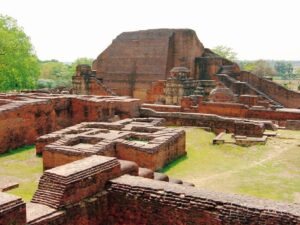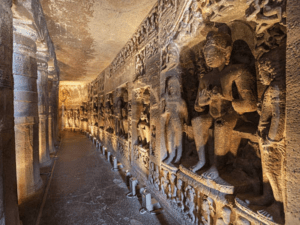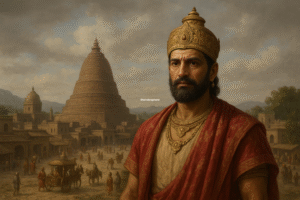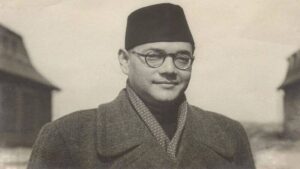Ujjain: Geography and Timeless Position
Ujjain lies on the serene banks of the Shipra River in central India’s Madhya Pradesh. Its almost perfect position on the Tropic of Cancer made it not only a geographical landmark but also an astronomical reference point for centuries. More importantly, Ujjain sat at the meeting point of two ancient superhighways: the Uttarapatha (north–south route) and the Dakshinapatha (east–west route), connecting the Ganges plains with Gujarat’s ports and the Deccan’s wealth. This made it a natural capital, a marketplace, and a sacred space all at once.
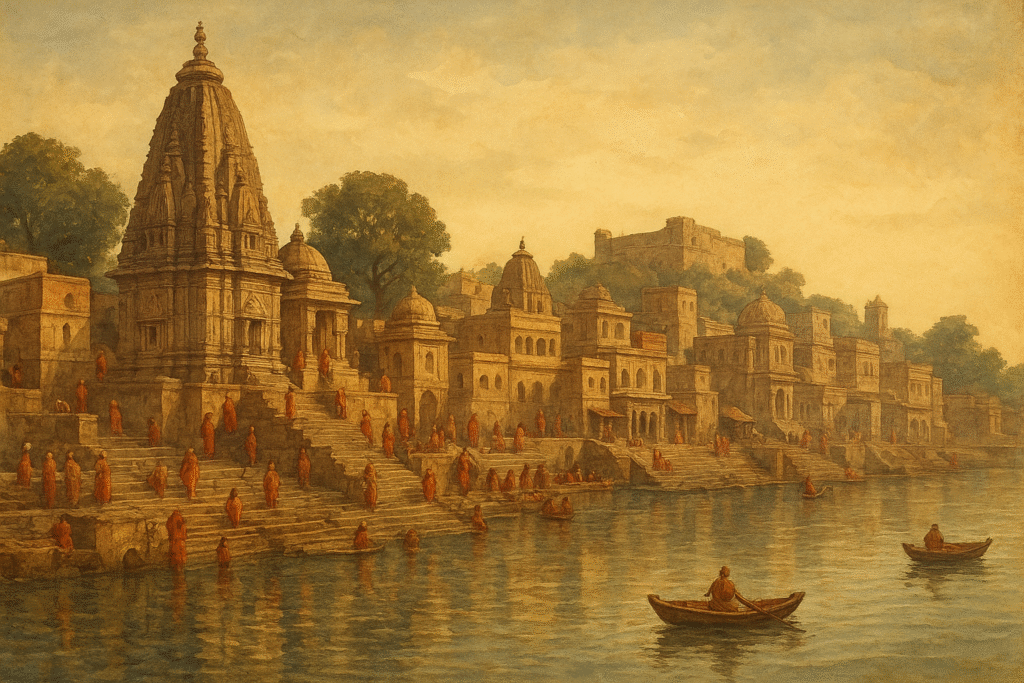
Myth and Sacred Legacy
In Hindu tradition, Ujjain (ancient Ujjayini) is one of the Sapta Puri — the seven holiest cities believed to grant liberation (moksha). Legend holds that during the Samudra Manthan (Churning of the Ocean), drops of the nectar of immortality (amrit) fell here, making it one of the four venues for the Kumbh Mela.
The city is also the stage for the stories of King Vikramaditya, whose legendary court of scholars included the poet Kalidasa, and whose name lives on in the Vikram Samvat calendar still used today.
Astronomy and Timekeeping
Ujjain became an intellectual center for astronomy and mathematics. It was considered the prime meridian of ancient India for astronomical calculations.
The great astronomer Varahamihira lived here during the Gupta period (5th–6th century CE), contributing to astronomy, astrology, and mathematics. Later, in the 18th century, Maharaja Jai Singh II of Jaipur built the Jantar Mantar observatory in Ujjain to continue its astronomical tradition.
Ancient Beginnings – The Avanti Capital (6th–4th Century BCE)
Ujjain’s recorded history begins in the Mahajanapada period, when it was the capital of Avanti, a powerful kingdom rivaling Magadha.
Notable Rulers: Pradyota Mahasena – Expanded Avanti’s influence and waged wars against Magadha.
Significance: Controlled central India’s trade routes. Early stronghold of Buddhist and Jain communities. A political counterweight to the eastern powers.
Mauryan Power and Ashoka’s Governorship (4th–2nd Century BCE)
Chandragupta Maurya annexed Avanti, making Ujjain a vital Mauryan provincial capital.
Ashoka governed here before becoming emperor, marrying Devi, a local woman. Their children, Mahinda and Sanghamitta, later carried Buddhism to Sri Lanka.
Highlights:
Expansion of Buddhism.
Strengthened north–south and east–west trade.
Administrative and military headquarters for central India.
The Age of Traders and Invaders (2nd Century BCE – 4th Century CE)
Following the Mauryas:
- Shungas reasserted Hindu traditions.
- Satavahanas used Ujjain to control Deccan trade.
- Western Satraps connected Ujjain to Indo-Roman commerce, evidenced by coinage and inscriptions.
Gupta Golden Age (4th–6th Century CE)
Ujjain reached cultural and scientific brilliance under the Gupta Empire.
Key Figures:
- Chandragupta II (Vikramaditya) – Patron of arts and sciences.
- Kalidasa – Produced literary masterpieces such as Meghaduta.
- Varahamihira – Created influential astronomical and astrological treatises.
Importance: Recognized as India’s prime meridian. A city where literature, mathematics, and astronomy thrived.
Medieval Dynasties and Conflicts (7th–13th Century)
- Vardhanas under Harsha kept Ujjain prominent.
- Rashtrakutas briefly took control during northern expeditions.
- Paramaras of Malwa, especially King Bhoja (1010–1055 CE), restored Ujjain’s scholarly glory with advances in literature, architecture, and education.
- Frequent conflicts with Chalukyas, Kalachuris, and others.
Sultanate, Mughals, and Marathas (13th–18th Century)
- Delhi Sultanate invasions led by Iltutmish and Alauddin Khalji damaged temples, including Mahakaleshwar.
- Mughals, especially Akbar, incorporated Ujjain into Malwa Subah; Jahangir visited and wrote about it.
- Marathas seized Ujjain in the 18th century; the Scindias made it their capital before shifting to Gwalior.
Colonial and Modern Periods
In the 19th century, Ujjain was incorporated into British India under the Scindia princely state. Trade in cotton, textiles, and agricultural produce remained important. Post-independence, it became part of Madhya Pradesh.
Today, Ujjain blends its historic layers with modern life, sustaining its identity as both a spiritual capital and a repository of India’s astronomical heritage.
Religious and Cultural Importance Today
The city’s spiritual landscape is dominated by the Mahakaleshwar Jyotirlinga, one of the twelve sacred Jyotirlingas of Lord Shiva. The temple, rebuilt multiple times after invasions, remains a pilgrimage center of national importance.
Ujjain also hosts the Simhastha Kumbh Mela every 12 years, attracting millions of pilgrims. Still home to astrology schools and a living tradition of Sanskrit scholarship.
Why Ujjain Was and Is So Important
- Strategic Trade Hub – Controlled vital crossroads of ancient India.
- Religious Magnet – One of the Sapta Puri, Jyotirlinga site, Kumbh Mela venue.
- Scientific Center – India’s prime meridian, center of ancient astronomy.
- Political Capital – Seat for dynasties from Pradyotas to Scindias.
- Cultural Beacon – Produced legendary poets, mathematicians, and architects.
Ranking Among the Oldest Cities
With archaeological evidence of settlement for at least 3,000 years and continuous urban life for over 2,500 years, Ujjain ranks among the world’s top ten oldest continuously inhabited cities, alongside Damascus, Jericho, Byblos, Athens, and Varanasi.
Legacy
Ujjain’s story is one of endurance and reinvention. It has stood as:
- A royal capital through empires and invasions.
- A spiritual center for millions.
- A scientific landmark that guided India’s timekeeping and astronomy.
Even today, walking its ghats or standing in the Mahakaleshwar temple’s courtyard, you are not just visiting a city — you are touching a thread that runs unbroken through the fabric of human civilization itself. It remains a vital link to understanding India’s religious traditions, scientific advances, and shifting political landscapes over millennia.
Chronological Timeline of Ujjain
| Period / Date | Key Phase | Notes |
|---|---|---|
| ~2000 BCE | Chalcolithic settlement | Archaeological evidence of human habitation in the Ujjain region; early farming and copper use. |
| ~1000 BCE | Iron Age habitation | Development of more permanent settlements along the Shipra River. |
| ~700–600 BCE | Urbanization – Avanti Capital | Ujjain (Ujjayini) emerges as capital of the Avanti Mahajanapada; key trade and political hub. |
| ~500 BCE | Pradyota Dynasty | Expansion of Avanti’s influence; rivalry with Magadha. |
| ~320 BCE | Mauryan Annexation | Chandragupta Maurya incorporates Ujjain into the Maurya Empire; Ashoka serves as governor. |
| ~185 BCE – 1st c. BCE | Shunga & Satavahana Eras | Hindu revival and Deccan trade dominance. |
| 2nd c. CE – 4th c. CE | Western Satrap Control | Indo-Scythian rule; Indo-Roman trade. |
| 4th – 6th c. CE | Gupta Golden Age | Cultural and scientific zenith under Chandragupta II (Vikramaditya); home to Kalidasa & Varahamihira. |
| 7th – 8th c. CE | Vardhana & Rashtrakuta Influence | Continued regional importance. |
| 9th – 13th c. CE | Paramara Rule | King Bhoja’s scholarly patronage; conflicts with Chalukyas and Kalachuris. |
| 13th – 16th c. CE | Delhi Sultanate Rule | Invasions and temple destruction; rebuilding cycles begin. |
| 16th – 18th c. CE | Mughal & Maratha Periods | Akbar includes Ujjain in Malwa Subah; Scindias make it their capital. |
| 1818 CE | British Annexation | After Anglo-Maratha Wars; revival of religious festivals. |
| 1947 CE – Present | Independent India | Part of Madhya Pradesh; major pilgrimage and heritage city. |

